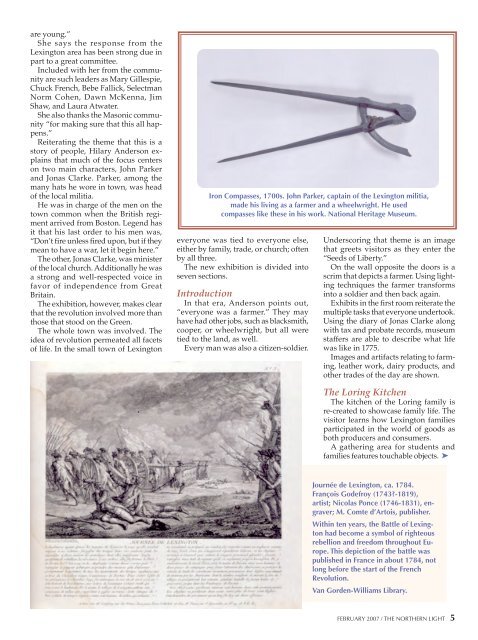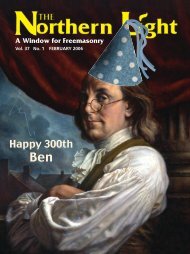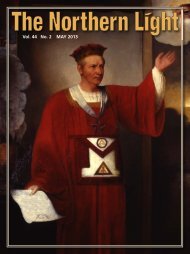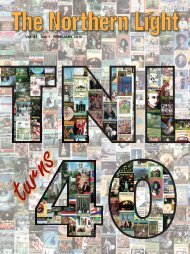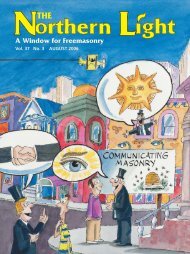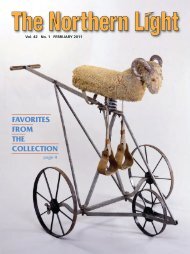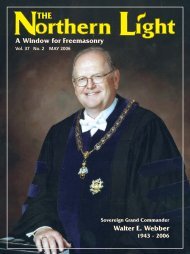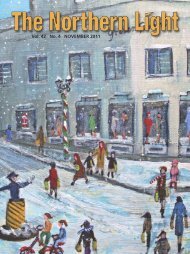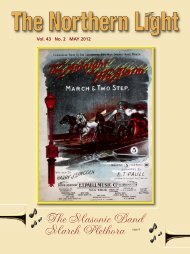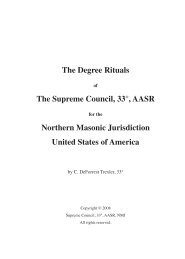February - Scottish Rite
February - Scottish Rite
February - Scottish Rite
You also want an ePaper? Increase the reach of your titles
YUMPU automatically turns print PDFs into web optimized ePapers that Google loves.
are young.”<br />
She says the response from the<br />
Lexington area has been strong due in<br />
part to a great committee.<br />
Included with her from the community<br />
are such leaders as Mary Gillespie,<br />
Chuck French, Bebe Fallick, Selectman<br />
Norm Cohen, Dawn McKenna, Jim<br />
Shaw, and Laura Atwater.<br />
She also thanks the Masonic community<br />
“for making sure that this all happens.”<br />
Reiterating the theme that this is a<br />
story of people, Hilary Anderson explains<br />
that much of the focus centers<br />
on two main characters, John Parker<br />
and Jonas Clarke. Parker, among the<br />
many hats he wore in town, was head<br />
of the local militia.<br />
He was in charge of the men on the<br />
town common when the British regiment<br />
arrived from Boston. Legend has<br />
it that his last order to his men was,<br />
“Don’t fire unless fired upon, but if they<br />
mean to have a war, let it begin here.”<br />
The other, Jonas Clarke, was minister<br />
of the local church. Additionally he was<br />
a strong and well-respected voice in<br />
favor of independence from Great<br />
Britain.<br />
The exhibition, however, makes clear<br />
that the revolution involved more than<br />
those that stood on the Green.<br />
The whole town was involved. The<br />
idea of revolution permeated all facets<br />
of life. In the small town of Lexington<br />
Iron Compasses, 1700s. John Parker, captain of the Lexington militia,<br />
made his living as a farmer and a wheelwright. He used<br />
compasses like these in his work. National Heritage Museum.<br />
everyone was tied to everyone else,<br />
either by family, trade, or church; often<br />
by all three.<br />
The new exhibition is divided into<br />
seven sections.<br />
Introduction<br />
In that era, Anderson points out,<br />
“everyone was a farmer.” They may<br />
have had other jobs, such as blacksmith,<br />
cooper, or wheelwright, but all were<br />
tied to the land, as well.<br />
Every man was also a citizen-soldier.<br />
Underscoring that theme is an image<br />
that greets visitors as they enter the<br />
“Seeds of Liberty.”<br />
On the wall opposite the doors is a<br />
scrim that depicts a farmer. Using lighting<br />
techniques the farmer transforms<br />
into a soldier and then back again.<br />
Exhibits in the first room reiterate the<br />
multiple tasks that everyone undertook.<br />
Using the diary of Jonas Clarke along<br />
with tax and probate records, museum<br />
staffers are able to describe what life<br />
was like in 1775.<br />
Images and artifacts relating to farming,<br />
leather work, dairy products, and<br />
other trades of the day are shown.<br />
The Loring Kitchen<br />
The kitchen of the Loring family is<br />
re-created to showcase family life. The<br />
visitor learns how Lexington families<br />
participated in the world of goods as<br />
both producers and consumers.<br />
A gathering area for students and<br />
families features touchable objects. ➤<br />
Journée de Lexington, ca. 1784.<br />
François Godefroy (1743?-1819),<br />
artist; Nicolas Ponce (1746-1831), engraver;<br />
M. Comte d’Artois, publisher.<br />
Within ten years, the Battle of Lexington<br />
had become a symbol of righteous<br />
rebellion and freedom throughout Europe.<br />
This depiction of the battle was<br />
published in France in about 1784, not<br />
long before the start of the French<br />
Revolution.<br />
Van Gorden-Williams Library.<br />
FEBRUARY 2007 / THE NORTHERN LIGHT 5


